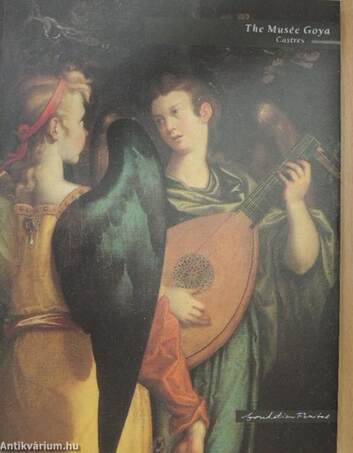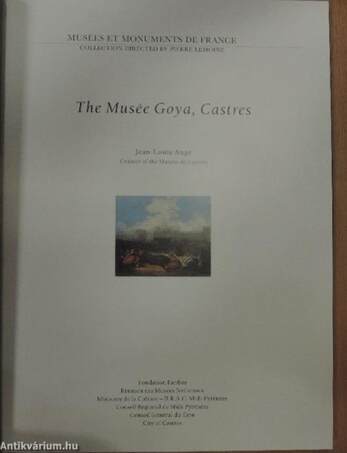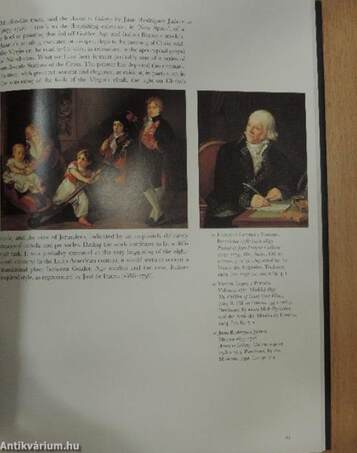1.067.317
kiadvánnyal nyújtjuk Magyarország legnagyobb antikvár könyv-kínálatát

VISSZA
A TETEJÉRE
JAVASLATOKÉszre-
vételek
The Musée Goya, Castres
| Kiadó: | Fondation Paribas |
|---|---|
| Kiadás helye: | |
| Kiadás éve: | |
| Kötés típusa: | Fűzött papírkötés |
| Oldalszám: | 126 oldal |
| Sorozatcím: | Musées et Monuments de France |
| Kötetszám: | |
| Nyelv: | Angol |
| Méret: | 28 cm x 21 cm |
| ISBN: | 2-9118-0912-2 |
| Megjegyzés: | Fekete-fehér és színes fotókkal, reprodukciókkal. További kapcsolódó személyek a könyvben. |
naponta értesítjük a beérkező friss
kiadványokról
naponta értesítjük a beérkező friss
kiadványokról
Előszó
Histoiy of the Museum
The Birth of the Museum
The museum in Castres was not always called the Musée Goya. This prestigious title in fact only dates from 1947. None the less, even before the... Tovább
Előszó
Histoiy of the Museum
The Birth of the Museum
The museum in Castres was not always called the Musée Goya. This prestigious title in fact only dates from 1947. None the less, even before the post-war period, the museum had followed an extremely interesting historical path.
The town of Castres began to take shape in the ninth century around the abbey of Saint-Benoît, which stood on the site occupied by the present cathedral. As well as being a trading city, it was a cultural centre, and, during the seventeenth century, it boasted an academy, founded on 19 November 1648. Another important institution, the celebrated Chambre de I'Edit or Chambre mi-partie, which came into being as a result of the 1577 Edict of Poitiers, was installed in Castres, a protestant city, on 22 March 1632. Tliis body, which was charged with resolving disputes between the two religious communities, brought a number of leading figures to Castres: Paul Pelisson-Fontanier {1624-93), future secretary to the king and member of the Académie française; Pierre de Fermât (1601-61), the great mathematician, who served for eight years in the Chambre de I'Edit and spent his last days in Castres; the pastor Raymond Gachés (c. 1615-68), a talented orator. The most interesting figure, for our purposes, was Pierre Borel (Castres c. 1620—71), physician to the king, author of the Antiquitez de Castres (1649), and owner of a remarkable cabinet of curiosities.
Unformnately, the departure of the Chambre de I'Edit (to Castel-naudary) in 1670 and the disappearance of the academy, the last session of which took place on 15 April 1670, interrupted this trend. From 1665 to 1673, during the episcopate of Monseigneur Michel de Tubceuf, confessor to Louis XIII, a new bishop's palace was built, to a design by Jules Hardouin-Mansart, with gardens by Le Nôtre (1670). The project was intended as an affirmation of royal power and of the Cathohc religion. The building took on a firmly national character during the Revolution and was acquired by the municipality in 1794. The local authorities took up residence in it, and have remained there to this day. It was not until the eighteenth century that a school of drawing was established in Castres - an event fostered by the presence of two Masonic lodges and, from 1750, by the activities of the Labarthe family. The school came into being in 1786, at the initiative of the consuls, and its running was entrusted to a M. Dauphin, who was charged with providing free instruction. Dauphin also played quite an important role in Castres during the Revolution.
The first attempt to create a museum in Castres dates from 1792, and was due to Jean Jacques Louis Béranger (Geneva 1736-Réalmont 1802) and his assistant, Rousseau, a painter and architect. Having been instructed by the Comité d'Instruction publique (public education commit-
Madrid school, 17th century Wedding Feast at Cam, detail (see also fig. 36) Vissza
Tartalom
Contents
Foreword
History of the Museum
The Birth of the Museum The Major Donations
From the 'Musée de Castres' to the 'Musée Goya' The Middle Ages and the Renaissance The Golden Age
Goya and the Eighteenth Century The Nineteenth Century The Twentieth Century
The Briguiboul and Jumel de Noireterre Collections Sculpture and Objets d'Art Graphic Art and the Goya Prints Index and Bibliography
5
7
7 9
13 17
27
49 61
77
89
97
III
126
Témakörök
- Idegennyelv > Idegennyelvű könyvek > Angol > Művészetek > Művészettörténet, általános
- Idegennyelv > Idegennyelvű könyvek > Angol > Művelődéstörténet
- Művelődéstörténet > Intézményei > Múzeumok
- Művészetek > Művészettörténet általános > Múzeumok, képtárak > Külföldi > Európai
- Művészetek > Művészettörténet általános > Idegen nyelv > Angol
- Művészetek > Művészettörténet általános > Kiállítások, aukciók, katalógusok > Külföldi










